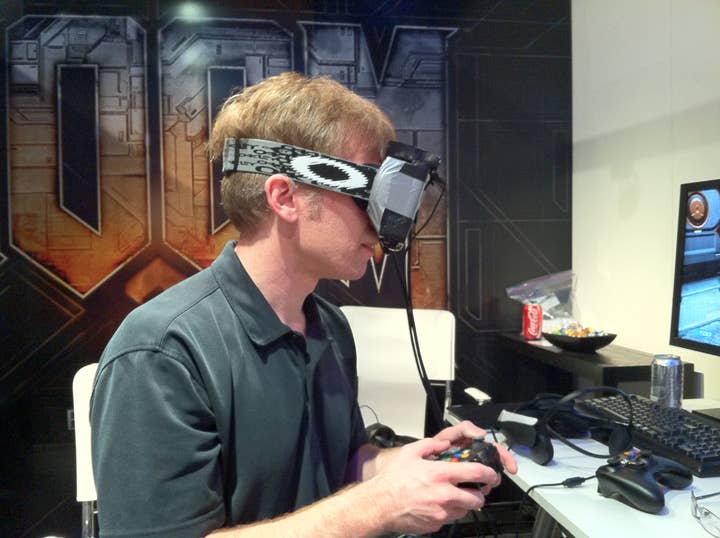John Carmack "not all that excited" by next-gen hardware
The legendary programmer does see a bright future with VR headsets though
Virtual reality, once thought of as a gimmicky, far-fetched idea, is becoming reality, and id Software's John Carmack is pushing hard to make VR headsets a part of every gamer's standard equipment. The Doom creator spent most of E3 showing off his own special VR headset in conjunction with the Doom 3 BFG Edition. For Carmack, prettier graphics are nice, but they won't fundamentally change the gameplay experience; VR, on the other hand, could have a dramatic impact.
As it turns out, a man by the name of Palmer Luckey had been working on something similar to what Carmack was tooling around with: an Oculus Rift head-mounted display.
"I was building these things myself but then I came across another guy with a huge personal collection of head mount displays and he's been working on these in his workshop. He's offering this as a kit for only $500, and he sent it to me. I added my sensors and software and stuff on there... When we decided to re-issue Doom 3, the thought was 'how do you interest people in an 8-year old title?' The idea was that we had serious stuff, Microsoft and Sony are pushing the 3D TV stuff, but I'm still not a huge backer of that. I think I did as good a job as possible with it. It's kind of neat, but it's a toss-up if you want to play it, especially on a console where you have to deal with frame-rate."
"In many ways I am not all that excited about the next generation. It will let us do everything we want to do now, with the knobs turned up"
John Carmack
"[Luckey] is starting a Kickstarter to help fund the first batch at $100 a kit. The hope is to sell these at $500 a kit with sensor and a copy of Doom 3 it could be about $600. I may wind up subsidizing a set of this first batch as they are so incredibly cool. I'm hoping that we will have these available around August... to have a chance, to have an impact on how VR is going to go, as this is better than most high-end units."
Interestingly, while the demo we played was with an Xbox 360 controller, Microsoft hasn't shown much interest, while Sony has, Carmack noted. Not only that, but Carmack told us that he's "actually going to be talking with Valve next month." Carmack didn't say who this was, but we're guessing it's Valve's Michael Abrash, who's already spoken publicly of his interest in wearable computing.
"I got a friend up there who is working with augmented reality, so there is a lot of overlap. It will be fun sitting down to talk about that stuff. So yeah, it is one of those things that we feel we're on the cusp of something rolling. This is neat, but I know three ways we can make this much better with available things, it just takes more effort and work. This is all stuff that can be done, it is not expensive and certainly in a price point of something like this could be a radical experience," Carmack said.
The demo we tried was certainly impressive, and the goggles do track your head motions, mapped to the left analog aiming controls, pretty well. The downside is it's a somewhat isolating experience.

"Certainly it doesn't cover every gaming experience, because a lot of gaming is social. It is you and your buddy sitting there, and eventually you will be able to see your buddy's avatar and everything, but there is still the living room atmosphere that you won't get with something like this. I do think it will be able to cover a large fraction of the gaming market out there though," Carmack told us.
Carmack sees this as just the beginning, and he thinks it can tie in nicely to the booming mobile market. "In a couple years, we hope that instead of being tethered to a PC, you build it off mobile-phone hardware, an iPhone 5 or whatever. No wires, you use the cameras for optical positioning and then you can walk around. You can set up your arena and play in Virtual Reality," he said.
"Sony and Microsoft are going to fight over gigaflops and teraflops and GPUs and all this. In the end, it won't make that much difference. When you get to this, it makes a really big difference in the experience"
John Carmack
"It won't sweep the world in a year or two, but so much of what we've always been trying to do with games is simulate that holodeck experience and put you in a different world. This could do it in a way that you could never, ever get in a traditional game," he continued. "The thing is, when you walk around E3, you are still looking into a screen playing an interactive movie. That's just not the same level of experience that you get with this. You can integrate additional factors of actual motion. With a different sensor on here, you can get down on your hands and knees and put your hands on the virtual floor. That's really, really cool."
It's always enjoyable to listen to someone speak on a topic they're hugely passionate about, and we could tell that Carmack could barely contain himself while talking about VR and his headset. This, he argues, not the fight over polygons, is what can change the industry.
"Sony and Microsoft are going to fight over gigaflops and teraflops and GPUs and all this. In the end, it won't make that much difference. When you get to this, it makes a really big difference in the experience. Nintendo went and brought motion into the gaming sphere and while only having a tenth of the processing power was able to outsell all of them in all of these ways. I think someone has an opportunity to do this here. It takes a whole ecosystem though, but it is almost perfect," he enthused.
Carmack asserted that Microsoft should have put its research into something like this VR technology rather than Kinect. "They screwed up the latency on all of it... I still think it is unfortunate; they did some very good software work in that, but it should have gone into something like this though," he said.
Ultimately, technology doesn't hold back game designers anymore, Carmack said and that's why he doesn't view the next graphical leap as being too important.
"When people ask how tapped out is the current console generation, PCs are 10 times as powerful but you really are still not technically limited. Any creative vision that a designer could come up with, we can do a pretty good job representing on current generation and certainly on PC. In many ways I am not all that excited about the next generation. It will let us do everything we want to do now, with the knobs turned up," he said.
"If you take a current game like Halo which is a 30 hertz game at 720p; if you run that at 1080p, 60 frames with high dynamic frame buffers, all of a sudden you've sucked up all the power you have in the next-generation. It will be what we already have, but a lot better. You will be able to redesign with a focus on D11, but it will not really change anyone's world. It will look a lot better, it will move towards the movie rendering experience and that is better and better, but it's not like the first time you've ever played an FPS. It won't be like putting yourself in the virtual world. All the little things you can do on that, such as playing an audio cue over here, and turning your attention to that. That will be more of the discontinuous step like we've had with first going to 3D or first using a mouse," he elaborated.
So when will VR headsets fulfill Carmack's dream and become a mainstream market reality? It's hard to say, but Luckey's Kickstarter is beginning in another week or two and then if a major player gets involved, who knows?
"As a fully consumer thing, it is hard to imagine that happening in less than a year. Sony is already interested in this thing, and they are interested in seeing how they want to follow this up. I can easily imagine something like that. Sony conceivably could have a product out in the next year. I have no inkling on internal plans, but as a company I think they can do it," Carmack said.

